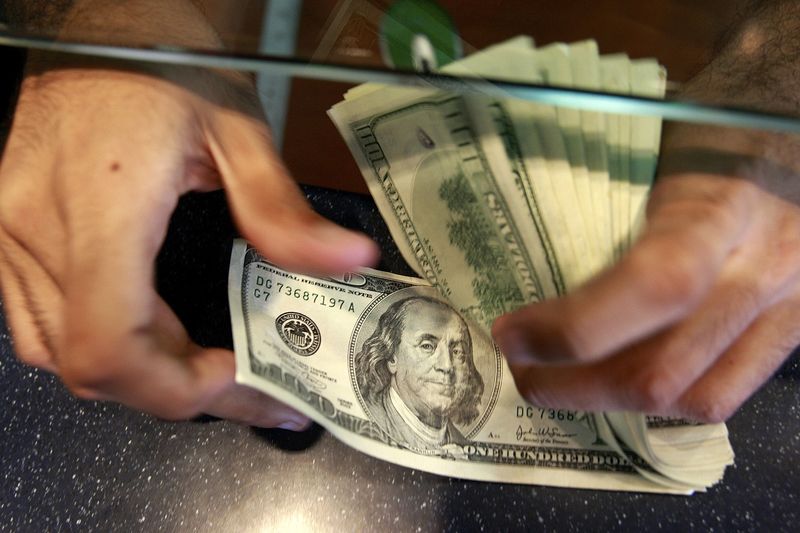Forex
Dollar rebounds as Fed’s Williams talks down rate cuts


© Reuters. A currency dealer counts U.S. dollars at his shop in Karachi October 8, 2008. REUTERS/Athar Hussain/Files
2/2
By Karen Brettell
NEW YORK (Reuters) -The dollar rebounded on Friday after Federal Reserve Bank of New York President John Williams pushed back against the market’s rate cut expectations, though the remained on track for its worst weekly performance in a month.
The dollar tumbled broadly after updated interest rate projections of Fed officials released on Wednesday showed an expectation for 75 basis points in cuts in 2024.
Fed Chairman Jerome Powell was also interpreted as striking a more dovish tone at the conclusion of the U.S. central bank’s two day meeting, when he said that the tightening of monetary policy is likely over, with a discussion of cuts coming “into view.”
But Williams said on Friday that “we aren’t really talking about rate cuts right now” at the Fed and it’s “premature” to speculate about them.
“It strikes some of the similar tones that we heard from Powell earlier this week but it kind of reinforces the fact that the Fed is still very much a data dependent bank and not really endorsing what the market’s pricing in to a degree,” said Bipan Rai, North American head of FX strategy at CIBC Capital Markets in Toronto.
Rai also noted that a large part of the move in the dollar this week has been due to rebalancing positions that were heavily tilted towards the greenback and focused in specific currency pairs, such as against the Japanese yen.
“This is a story about the inordinate amount of leverage and skewed positioning in the market that needed to be rebalanced more than any sort of dovish interpretation of what Powell said earlier this week,” he said.
Traders are pricing in aggressive expectations for rate cuts, with the first reduction seen likely in March and 141 basis points in cuts seen by December.
Atlanta Fed President Raphael Bostic said on Friday that the U.S. central bank can begin reducing interest rates “sometime in the third quarter” of 2024 if inflation falls as expected.
Chicago Fed President Austan Goolsbee also said that the Fed may soon need to shift its focus to preventing a run-up in unemployment from fighting inflation.
Data on Friday showed that production at U.S. factories rose in November, lifted by a rebound in motor vehicle output following the end of strikes, but activity was weaker elsewhere as manufacturing grapples with higher borrowing and softening demand for goods.
The dollar index was last up 0.56% on the day at 102.52. It fell to 101.76 on Thursday, the lowest since Aug. 10. The index is on track for a weekly loss of 1.39%, the worst weekly performance since Nov. 19.
The euro fell 0.83% to $1.0899. It reached $1.1009 on Thursday, the highest since Nov. 29. Sterling dropped 0.60% to $1.2690, after reaching $1.2793 on Thursday, the highest since Aug. 22.
The euro and sterling were supported on Thursday by the European Central Bank (ECB) and Bank of England pushing back against rate cuts.
Investors are nonetheless still betting heavily on rate cuts from both central banks next year.
The ECB has more scope than most to ease, according to Pepperstone strategist Chris Weston, given low euro zone growth and a rapid decline in inflation.
“However, the pushback from (ECB President) Lagarde and co suggests conjecture on the timing of initial easing – perhaps this is a function that it’s desirable to keep one’s currency strong to limit imported inflation.”
The euro was also dented by surveys on Friday showing that the downturn in euro zone business activity surprisingly deepened in December.
The Bank of Japan is the last of the major central banks to meet this month and the question among traders and investors is whether or not it will signal its intention to ditch its policy of keeping interest rates at rock bottom next week.
The dollar was last up 0.24% at 142.18 yen, after dropping to 140.95 on Thursday, the lowest since July 31. The greenback is on track to post its worst week against the Japanese currency since July 14 with a 1.94% fall.
fell 2.1% to $42,130.
========================================================
Currency bid prices at 3:00PM (2000 GMT)
Description RIC Last U.S. Close Pct Change YTD Pct High Bid Low Bid
Previous Change
Session
Dollar index 102.5200 101.9700 +0.56% -0.937% +102.6400 +101.8300
Euro/Dollar $1.0899 $1.0992 -0.83% +1.73% +$1.1004 +$1.0885
Dollar/Yen 142.1750 141.8450 +0.24% +8.44% +142.4600 +141.4500
Euro/Yen 154.97 155.98 -0.65% +10.46% +156.4900 +154.4200
Dollar/Swiss 0.8700 0.8677 +0.28% -5.90% +0.8707 +0.8654
Sterling/Dollar $1.2690 $1.2767 -0.60% +4.93% +$1.2790 +$1.2669
Dollar/Canadian 1.3371 1.3407 -0.27% -1.32% +1.3415 +1.3350
Aussie/Dollar $0.6706 $0.6698 +0.12% -1.62% +$0.6728 +$0.6664
Euro/Swiss 0.9481 0.9535 -0.57% -4.18% +0.9541 +0.9456
Euro/Sterling 0.8587 0.8610 -0.27% -2.91% +0.8617 +0.8572
NZ $0.6209 $0.6207 +0.03% -2.21% +$0.6229 +$0.6180
Dollar/Dollar
Dollar/Norway 10.4570 10.5020 -0.31% +6.67% +10.5610 +10.4340
Euro/Norway 11.4013 11.5451 -1.25% +8.65% +11.5634 +11.3840
Dollar/Sweden 10.2654 10.2330 -0.56% -1.37% +10.3235 +10.2057
Euro/Sweden 11.1897 11.2527 -0.56% +0.36% +11.2789 +11.1810

 Forex3 years ago
Forex3 years agoForex Today: the dollar is gaining strength amid gloomy sentiment at the start of the Fed’s week

 Forex3 years ago
Forex3 years agoUnbiased review of Pocket Option broker

 Forex3 years ago
Forex3 years agoDollar to pound sterling exchange rate today: Pound plummeted to its lowest since 1985

 Forex3 years ago
Forex3 years agoHow is the Australian dollar doing today?

 Cryptocurrency3 years ago
Cryptocurrency3 years agoWhat happened in the crypto market – current events today

 World3 years ago
World3 years agoWhy are modern video games an art form?

 Commodities3 years ago
Commodities3 years agoCopper continues to fall in price on expectations of lower demand in China

 Economy3 years ago
Economy3 years agoCrude oil tankers double in price due to EU anti-Russian sanctions





















